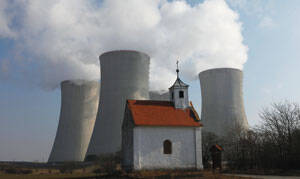The radioactive peril emerging from the badly damaged Fukushima Daiichi nuclear energy facility in northern Japan showed no sign of abating on March 23 as Japanese officials reported that dangerous levels of radioactive iodine-131 were appearing in Tokyo’s water supply. Parents in Tokyo were warned not to allow infants to drink tap water as efforts continued to contain radiation leaks at the plant. Fukushima Daiichi was fatally crippled during the historic devastation caused by the earthquake and tsunami on March 11 that ravaged Japan’s northeastern coast. Food shipments from Fukushima Prefecture and the neighboring Ibaraki Prefecture were also halted after radioactive contamination was discovered in vegetable and milk samples.
The ongoing crisis at the Fukushima facility raises not only environmental and health issues, but also ethical questions about energy use and the future of global nuclear power. The accident could be a “huge wake-up call” that would “give impetus to jump-starting massive research” in other energy technologies, such as solar and wind power, said William French, director of the Center for Ethics at Loyola University Chicago. Accidents at Three Mile Island in Pennsylvania in 1979 and at Chernobyl, Ukraine, in 1986 triggered “deep fear” about nuclear energy, French said. In recent years, however, concern about climate change and calls to reduce the use of fossil fuels like oil and coal, which emit greenhouse gases that contribute to global warming, have led some policy makers to take another look at nuclear energy.
Critics argue, however, that if the entire fuel cycle of nuclear energy, from mining through processing, is evaluated, the industry’s carbon footprint increases significantly. So does the cost. A single plant can cost more than $5 billion. And the industry has been notoriously reliant on hefty government subsidies, tax breaks, loan guarantees and limits on liability, whose combined value sometimes is more than that of the power the plants produce, according to a 2011 report by the Union of Concerned Scientists.
The U.S. Government Accountability Office reports that between 2002 and 2007 nuclear programs in the United States received $6.2 billion in government funding for research and development. That compares to $3.1 billion for fossil fuels and $1.4 billion for renewable energy. When subsidies are factored in, nuclear power ranks with solar energy among the least cost-efficient sources of electricity, according to the U.S. Department of Energy (behind, in order of efficiency, natural gas, hydro, conventional coal, wind, geothermal and biomass). Some experts say that if renewable energy sources, which do not raise long-term safety concerns, received the same subsidies as nuclear power, they would quickly become more competitive.
Nevertheless, Edward McAssey, professor emeritus of mechanical engineering at Villanova University in Pennsylvania, believes nuclear energy remains a viable option. Public reaction to the accident in Japan “is going to be a big hurdle to get over,” he said, but he believes plants can operate safely as long as countries avoid the design and engineering flaws that contributed to the crisis at Fukushima Daiichi. The facility’s fate was essentially sealed when the tsunami on March 11 washed away diesel fuel tanks intended to provide emergency power for the plant’s elaborate cooling system. Its battery-powered backup system operated for only eight hours.
But increasingly complicated technology can multiply risks, said Adam Briggle, assistant professor of philosophy at the University of North Texas. “The danger is to pretend that we can tame this complex technical beast by making it even more complex,” he said. One solution is to reduce energy consumption, he said, recognizing that “our individual lifestyle choices have public ramifications.”








